
Making and placing a satellite in an orbit is far more difficult than it sounds. There are many minute factors that affect the flight of a satellite. Satellites have different kinds of works like communication, bouncing signals to different parts of the world, etc. Imagine a world without satellites, no one will be able to watch television, no usage of cell phones and many more.
This article will show you how a satellite is assembled, and then it is sent to space. So, this is how it goes:
Assembly
The first part is the assembly of a satellite. Major components like radio transmitter, navigation system, photo-voltaic panels, system computers, etc. are put together in one piece. Some small components are also installed, like batteries and a precise clock (which is really important).
Once the main satellite is assembled, the focus shifts to building the lifter, which would take the satellite to space. The lifter consists of the components like fuel tanks, engines, a set of decouplers, and some solid-fuel booster too (mandatory). It should be noted that two engines are installed, first is the big one, which is used for launch, and second is a smaller one, which is used for maneuvering in space. Everything is assembled in a building called Vehicle Assembly Building (VAB). The components of a lifter are very massive, hence they cannot be installed by hand. Large cranes are used for this purpose.
The engine has to pass through several pre-launch tests, before it is installed in the lifter. If it passes these tests, then it is ready for launch, but if it doesn’t then the whole mission is aborted.
The shape of the spacecraft has to be precise. Even a single millimeter of mistake can cause the whole mission to be doomed. Ferrings, which are outer covering of a satellite, are installed. These are used because they make the ship more aerodynamic, and it experiences less atmospheric resistance.
When everything is assembled, and the scientists are satisfied with the ship, then the satellite and the lifter are attached together, and it becomes ready for launch.

Launch
The satellite is moved to the launch-pad, using a massive platform with automated wheels. The fuel tanks are kept empty to prevent the situation of an explosion if any mishap happens.
Once the combined satellite and lifter are on the launch-pad, millions of liters of fuel is filled in the fuel tanks, and launch stabilizers are also installed. When the tanks are completely filled, the satellite is ready for launch, and the countdown begins.
At 4, the pipes connecting the fuel tanks to the engine are opened, allowing the fuel to flow from the tanks to the engine. At 3, the fuel reaches the engine, where combustion takes place. At 2, the engine starts burning the fuel to gain thrust. And at 1, the fuel starts burning at a rapid rate, and the satellite starts ascending. If nothing bad happens, first part of the launch is successful.
While it ascends, it faces tremendous air resistance. But once it starts gaining height, the atmosphere starts getting thinner, and the resistance decreases too. Before reaching space, the spacecraft has to pass through Max Q, which is the point where the ship has to experience the highest amount of aerodynamic stress, and it starts to shudder violently. If the spacecraft passes the Max Q without any mishap, then booster are decoupled, and the launch is considered to be successful.

Out In Space
No one on earth knows where the atmosphere ends and space starts, but the scientist take that point as 70 kilometer above the earth’s surface.
Once the satellite gains the height of 70,000 meters, the people at the control room on the earth, remotely turn the spacecraft towards the horizon, and the fairings are then removed. The lifter part, that is the fuel tanks and the main engine, is decoupled too, and the secondary engine comes into play.
The nose of the satellite is pointed towards the horizon so that it starts creating an orbit around the earth. The supercomputers compute the current trajectory, and shows it to the people sitting in the spacecraft’s control room. When the satellite reaches the good height, the secondary engine is shut off. As the satellite reaches the apogee of the uncompleted orbit, the ship is pointed towards the prograde direction (the direction of the current velocity vector), and the engine is started, at full throttle.
Slowly, the orbit starts forming, and when a circular orbit is achieved, the secondary engine too is decoupled. The solar panels are opened, and the satellite is ready to do the work for which it was made.
This was the journey of a satellite from mere parts to space.
Thanks for reading!!

Hi, I found some acronyms/abbreviations in this post. This is how they expand:
Downvoting a post can decrease pending rewards and make it less visible. Common reasons:
Submit
satellite is important of our telecommunication sector
Downvoting a post can decrease pending rewards and make it less visible. Common reasons:
Submit